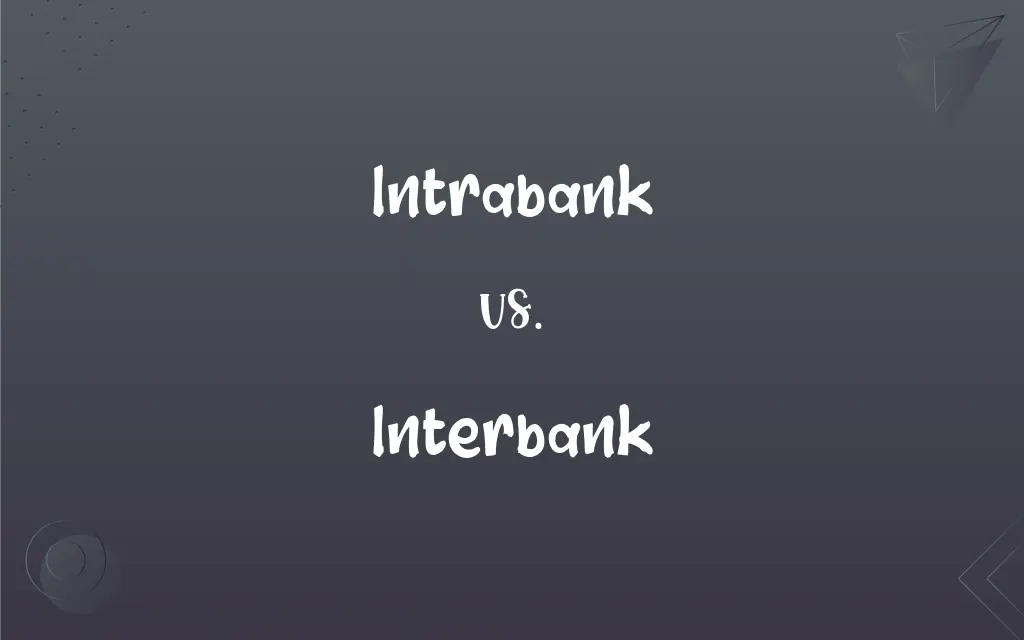Intrabank vs. Interbank: What's the Difference?
By Harlon Moss & Janet White || Updated on March 4, 2024
Intrabank transactions involve activities within the same bank, while interbank transactions occur between two different banks. Intrabank focuses on internal operations, whereas interbank deals with external banking relations.

Key Differences
Intrabank transactions are all about activities and services that occur within a single banking institution. This includes transfers of money between accounts held at the same bank, adjustments within the bank's internal systems, or any banking operations that do not require interaction with outside institutions. Interbank transactions, on the other hand, involve the movement of funds or other financial interactions between different banks. This can include interbank loans, payments processed from a customer of one bank to a customer of another, or the settlement of transactions through clearinghouses.
Intrabank activities are crucial for customer service, account management, and the day-to-day operations of a financial institution. They ensure that a customer's various accounts within the same bank can interact seamlessly, such as transferring money from a savings account to a checking account within the same bank. Interbank activities are essential for the global financial system, facilitating liquidity and financial stability across banks and allowing customers to conduct transactions with parties in different banking institutions. Examples include wire transfers from a customer at one bank to a customer at another, or the processing of check payments between banks.
The distinction between intrabank and interbank transactions highlights the scope and scale of banking operations, from the internal management of customer accounts to the broader network of financial institutions that make up the global banking ecosystem.
Comparison Chart
Definition
Transactions and activities within the same bank.
Transactions and activities between different banks.
Examples
Transferring money between a checking and savings account at the same bank.
Wire transfers, interbank loans, and clearing of checks between different banks.
ADVERTISEMENT
Focus
Internal account management and customer service.
External relations and liquidity management between banks.
Importance
Essential for seamless customer experience and internal operations.
Crucial for global financial stability and cross-bank transactions.
Regulatory Context
Governed by the bank's internal policies and procedures.
Subject to broader regulatory standards and interbank agreements.
Intrabank and Interbank Definitions
Intrabank
Internal bank transfers.
Moving funds from savings to checking within the same bank.
Interbank
Interbank lending.
One bank borrowing from another overnight to manage liquidity.
ADVERTISEMENT
Intrabank
Account adjustments.
Correcting a transaction error in a customer's account.
Interbank
Wire transfers.
Sending money from a customer at Bank A to a customer at Bank B.
Intrabank
Internal loans.
Issuing a credit line to a customer, managed within the bank.
Interbank
Clearing checks.
Processing a check written from an account at Bank A deposited into Bank B.
Intrabank
Within a single bank (financial institution).
Interbank
Of or relating to transactions or communication between banks
Interbank borrowing.
Interbank
Of, pertaining to, or taking place between two or more banks (financial institutions).
FAQs
What is the purpose of intrabank transactions?
Intrabank transactions aim to facilitate the management of a customer's various accounts within the same bank, ensuring seamless financial operations and customer service.
Why are interbank transactions important for the banking system?
Interbank transactions are vital for maintaining liquidity and financial stability across banks, enabling customers to conduct transactions with parties in different financial institutions.
How do interest rates affect interbank transactions?
Interest rates significantly impact interbank lending, as they determine the cost of borrowing and lending funds between banks.
What technologies are used to facilitate interbank transactions?
Technologies such as SWIFT (Society for Worldwide Interbank Financial Telecommunication) and blockchain are used to facilitate secure and efficient interbank transactions.
What security measures are common in interbank transactions?
Security measures for interbank transactions include encryption, multi-factor authentication, and continuous monitoring for fraudulent activity to protect the integrity of the transactions.
How do fluctuations in currency value affect interbank transactions?
Fluctuations in currency value can significantly impact interbank transactions involving foreign exchange, affecting the transaction's cost and the exchanged amount's value.
How do intrabank transactions affect a customer's banking experience?
Efficient intrabank transactions lead to a smoother, more integrated banking experience for customers, allowing for easy management of their financial assets within the bank.
What role do central banks play in interbank transactions?
Central banks often act as intermediaries or regulators in interbank transactions, ensuring the stability and integrity of the financial system.
Can intrabank transactions involve currency exchange?
Yes, if a bank offers multi-currency accounts, customers can perform currency exchanges within their accounts as intrabank transactions.
Do intrabank transactions incur fees?
Intrabank transactions typically incur fewer or no fees, as they involve the movement of funds within the same institution.
How do holidays and weekends affect the processing of interbank transactions?
Holidays and weekends can delay the processing of interbank transactions, as many banks and clearing systems do not operate on non-business days, leading to potential delays.
What role does the interbank market play in the global financial system?
The interbank market is crucial for the global financial system, allowing banks to manage liquidity, meet regulatory requirements, and facilitate international trade and investment through currency exchange and capital flows.
How are interbank transactions regulated?
Interbank transactions are regulated by financial authorities and central banks to ensure compliance with legal standards, anti-money laundering (AML) requirements, and to promote financial stability.
What is the difference in processing time between intrabank and interbank transactions?
Intrabank transactions are usually processed faster than interbank transactions due to the lack of need for external verification and the direct control of the bank over all internal processes.
Can customers initiate interbank transactions directly?
Yes, customers can initiate interbank transactions, such as wire transfers or check payments, which require processing and settlement between different banks.
How do banks communicate and settle interbank transactions?
Banks communicate and settle interbank transactions through networks like SWIFT, using agreed-upon protocols and systems for transaction processing, verification, and reconciliation.
What is the impact of digital banking on intrabank transactions?
Digital banking has streamlined intrabank transactions, allowing customers to easily manage their accounts, transfer funds, and access banking services online with greater speed and convenience.
Are there limits to the amount that can be transferred in intrabank and interbank transactions?
Both intrabank and interbank transactions may have limits set by the bank or regulatory authorities to manage risk, prevent fraud, and comply with anti-money laundering regulations.
Can interbank transactions be reversed?
Interbank transactions can sometimes be reversed, but this depends on the transaction type, the policies of the involved banks, and the timeframe within which the reversal request is made.
What challenges do banks face in managing intrabank and interbank transactions?
Challenges include maintaining security against fraud, ensuring compliance with evolving regulatory requirements, managing liquidity, and keeping up with technological advancements to facilitate efficient and reliable transactions.
About Author
Written by
Harlon MossHarlon is a seasoned quality moderator and accomplished content writer for Difference Wiki. An alumnus of the prestigious University of California, he earned his degree in Computer Science. Leveraging his academic background, Harlon brings a meticulous and informed perspective to his work, ensuring content accuracy and excellence.
Co-written by
Janet WhiteJanet White has been an esteemed writer and blogger for Difference Wiki. Holding a Master's degree in Science and Medical Journalism from the prestigious Boston University, she has consistently demonstrated her expertise and passion for her field. When she's not immersed in her work, Janet relishes her time exercising, delving into a good book, and cherishing moments with friends and family.































































